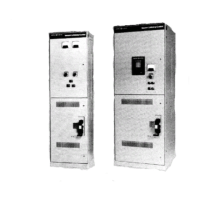CR194 Two-High Vacuum Limitamp@
Step 3.
If the contactor is a stationary type, install and torque
the three load side connection bolts to 16 ft-lb. (See
Figure 18), then attach the line cables to the bottom
of the fuse assembly and torque these connections to
9 ft-lb. (See Figure 20).
WARNING:
Be absolutely certain that these bolts
are properly installed and torqued. These are cur-
Step 4.
If the contactor is a drawout type, reinstall the two
positioning bolts (See Figure 19).
Step 5.
Manually operate the contactor armature and observe
that the mechanical interlock functions properly.
Step 6.
Reconnect the control umbilical cord to the contactoi
and be sure the retaining wing nuts are tight. Installa-
tion of the contactor is now complete.
WARNING:
Make certain that all barriers are re-
placed and bolted tightly into position. Make sure
the line and load side terminations of the station-
ary contactor are torqued properly. If the contactor
is drawout type, make sure the positioning bolts
are installed properly. Failure to perform these op-
erations could result in failure of the unit to oper-
ate safely and reliably.
Incoming Power Connections
The compact design of the two-high vacuum
Limitamp’ does not make it practical to terminate in-
coming power cables within the starter. The equip-
ment must either be bus spliced to existing equipment
or supplied with a separate cable entrance compart-
ment. If a separate cable entrance compartment is sup-
plied, refer to the Outline Summary & Outline Details
sections of the drawings provided with the equipment
to determine the recommended location for incoming
power cable entry. Also see the “Cable Termination
Guidelines” section of this instruction.
Grounding
All controller enclosures must be grounded, and the
CR194 two-high vacuum Limitamp@ is equipped with a
ground bus for that purpose. The two-high ground bus
should be bus connected to existing equipment or to a
separate cable entrance compartment. Figure 28 shows
the ground bus as seen from the rear of the enclosure
with the back cover removed.
In order to accommodate motor cable grounds, each
starter cubicle is equipped with a ground bus link that
is connected directly to the horizontal ground bus.
See Figure 29.
Figure 28.
Rear view of horizontal main and
ground bus with back covers removed
GRO
BUS
Figure 29. view of motor
terminal
area showing
ground bus lii in lower starter

